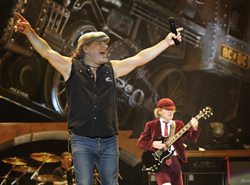
“It’s a great sounding console and also has a great surface to work on – just to move around the way it’s laid out. With this Pro 40, after having spent a few years in the studio with Malcolm and Angus while they wrote this latest album, I’d be sitting in there and I talked to Malcolm as you do about sound we’d listen to – we’d look at all sorts of options of recording stuff.
“Taking what I’ve learned from Malcolm with his delight with that kind of Neve sound, I thought well how could I approach this with something that is close to that. Obviously, I’m not going to tour with a Neve console. This console is as close as I’m going to get to a touring Neve. This sounds very, very, good.”
It’s a big swing from the last McCartney tour Pab mixed from 2003 to 2005. “I‘ve been using the Digidesign Profile on McCartney and a lot of the bigger projects I’ve been doing with him – most recently at the show in Tel Aviv. I used the Profile console with him because it suits the application as far as one minute we may be doing a theater and the next minute we’re rehearsing in his rehearsal facility, which is a barn where we literally got a cupboard to squeeze into. It’s been great for that job.”
So why employ analog?
“AC/DC isn’t a big fan of digital,” explained Pab. “They never thought the sound of a digital console is equal to an analog console. One of the things that Malcolm and Angus have in their studio facilities where they write is an old Neve 14 channel broadcast console and everything goes through it. They like that old Neve warmer sound. It’s not that digital isn’t warm, I think what happens with digital consoles is in the past, some of the earlier stuff had smaller sampling rates – it just needed to grow up a little.
“The higher frequencies are super smooth on the Pro 4. We’re enjoying that. This console was shipped out to us in rehearsals. It has a number of functions on this tour. It’s a back-up console and an opening act console. We can also record the show because the console is tracking directly to a Klark Teknik DN9696 high resolution hard disk recorder.”
Pab handles microphone selection, stating, “That decision is based upon a number of factors – what I want the microphones to be doing and then I have to look at how well they are going to work with the monitor engineer who has a whole different battle. Then I look at that particular microphone and the application.
“With the vocal microphone, there are a number of factors there also. It’s what Brian wants off the microphone, even down to how he can stuff it down his trousers if he’s running around or climbing the bell or whatever. There are a lot of things that go into the vocal microphone decision process.
“A lot of microphones are presented to you, new models that come out and you try this and you try that. I’ll only make a change when I find a great noticeable difference. I just need a good reliable mic for Brian so if it’s dropped or bounced around the stage, I’ll have something he can pick up and it’s good to go.
“The late great John Roden and I did a lot of work together and we tried all sorts of mics. For a monitor engineer and a FOH engineer, the Shure 58A suited a lot of acts that Roden and I worked with. It’s just a great microphone. I also tried out anything new when it comes out onto the market like the Telefunken M80 you brought me today. I’ll put it through the paces and let you know what I think.”
For more images, be sure to check out the photo gallery that accompanies this article.
